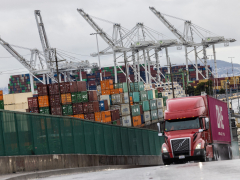China has accused the United States of “double standards” after US President Donald Trump threatened to impose an additional 100 percent tariff on Chinese goods in response to Beijing’s curbs on exports of rare earth minerals.
China says its export control measures announced last week were in response to the US restrictions on its entities and targeting of Beijing’s maritime, logistics and shipbuilding industries.
Recommended Stories
list of 4 items
- list 1 of 4China tightens export controls on rare-earth metals: Why this matters
- list 2 of 4Trump to hit China with 100 percent tariff amid escalating trade spat
- list 3 of 4China slams Trump’s 100 percent tariff threat, defends rare earth curbs
- list 4 of 4Will Trump’s tariffs push China and India closer?
end of list
Trump’s tariff threats, which come weeks ahead of the likely meeting between the US president and his Chinese counterpart Xi Jinping, have the potential to reignite a trade war months after Washington lowered the China tariffs from 125 to 30 percent.
The actions by the world’s two largest economies threaten to ignite a new trade war, adding further uncertainty to global trade. So what’s the recent history of US trade measures against China, and will the two countries be able to resolve their differences?
Why did China tighten export controls on rare earths?
On October 9, China expanded export controls to cover 12 out of 17 rare-earth metals and certain refining equipment, effective December 1, after accusing Washington of harming China’s interests and undermining “the atmosphere of bilateral economic and trade talks”.
China also placed restrictions on the export of specialist technological equipment used to refine rare-earth metals on Thursday.
Beijing justified its measures, accusing Washington of imposing a series of trade curbs on Chinese entities despite the two sides being engaged in trade talks, with the last one taking place in Madrid, Spain last month.
Foreign companies now need Beijing’s approval to export products containing Chinese rare earths, and must disclose their intended use. China said the heightened restrictions come as a result of national security interests.
China has a near monopoly over rare earths, critical for the manufacture of technology such as electric cars, smartphones, semiconductors and weapons.
The US is a major consumer of Chinese rare earths, which are crucial for the US defence industry.
At the end of this month, Trump and Xi are expected to meet in South Korea, and experts speculate that Beijing’s move was to gain bargaining advantage in trade negotiations with Washington.
China’s tightening of restrictions on rare earths is “pre-meeting choreography” before Trump’s meeting with Xi, Kristin Vekasi, the Mansfield chair of Japan and Indo-Pacific Affairs at the University of Montana, told Al Jazeera.
How did Trump respond?
On October 10, Trump announced the imposition of a 100 percent tariff on China, effective from November 1.
“Based on the fact that China has taken this unprecedented position … the United States of America will impose a Tariff of 100 percent on China, over and above any Tariff that they are currently paying,” Trump wrote in a post on his Truth Social platform.
He added that this would come into effect on November 1 or before that. Trump added that the US would also impose export controls on “any and all critical software”.
Earlier on October 10, Trump accused China of “trade hostility” and even said he might scrap his meeting with Xi. It is unclear at this point whether the meeting will take place.
“What the United States has is we have a lot of leverage, and my hope, and I know the president’s hope, is that we don’t have to use that leverage,” US Vice President JD Vance told Fox News on Sunday.
How did China respond to that?
China deemed the US retaliation a “double standard”, according to remarks by the Chinese Ministry of Commerce spokesperson on Sunday.
China said that Washington had “overstretched the concept of national security, abused export control measures” and “adopted discriminatory practices against China”.
“We are living in an era of deeper intertwining of security and economic policies. Both the US and China have expanded their conceptions of national security, encompassing a range of economic activities,” Manoj Kewalramani, chairperson of the Indo-Pacific Studies Programme at the Takshashila Institution in Bangalore, India, told Al Jazeera.
“Both have also weaponised economic interdependence with each other and third parties. There are, in other words, no saints in this game.”
Kewalramani said that China started expanding the idea of “national security” much earlier than others, especially with its “comprehensive national security concept” introduced in 2014.
Through this, China began to include many different areas, such as economics, technology, and society, under the term “national security”. This shows that China was ahead of other countries in broadening what counts as a national security issue.
China threatened additional measures if Trump went ahead with his pledge.
“Willful threats of high tariffs are not the right way to get along with China. China’s position on the trade war is consistent: we do not want it, but we are not afraid of it,” the Chinese Commerce Ministry spokesperson said in a statement.
“Should the US persist in its course, China will resolutely take corresponding measures to safeguard its legitimate rights and interests,” the statement said.
What trade measures has the US taken against China in recent history?
2025: Trump unleashes tariff war
A month after taking office for his second term, Trump signed an executive order imposing a 10 percent tariff on all imports from China, citing a trade deficit in favour of China. In this order, he also imposed tariffs on Mexico and Canada. China levied countermeasures, imposing duties on US products in retaliation.
In March, the US president doubled the tariff on all Chinese products to 20 percent as of March 4. China imposed a 15 percent tariff on a range of US farm exports in retaliation; these took effect on March 10.
Trump announced his “reciprocal tariffs,” imposing a 34 percent tariff on Chinese products. China retaliated, also announcing a 34 percent tariff on US products. This was the first time China announced export controls on rare earths.
Hours after the reciprocal tariffs went into effect, Trump paused them for all his tariff targets except China. The US and China continued to hike tit-for-tat levies on each other.
Trump slapped 145 percent tariffs on Chinese imports, prompting China to hit back with 125 percent tariffs. Washington and Beijing lat





